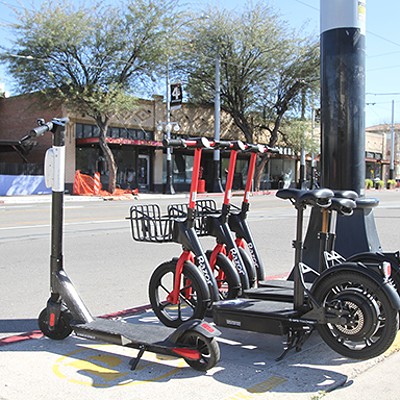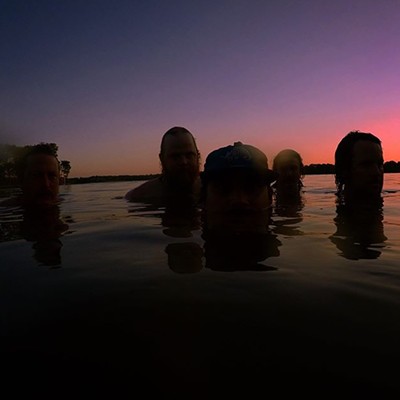The busty entertainer's words rang true at a public forum for downtown's proposed "rainbow bridge" containing the new UA Science Center on Thursday evening, April 27. New York-based architect Rafael Viñoly faced a monsoon of criticism from some attendees, who claimed the structure would be overwhelming, too expensive and incongruous with Tucson's Southwestern heritage.
"It's an interesting bridge; it's just the wrong place for it," Gayle Hartmann said over the phone, days after receiving a round of applause when she questioned the appropriateness of the structure at the forum. "Maybe Chicago would be a better place. It's a bigger city. It's got bigger buildings. It doesn't have the history we do."
An unsigned comment card expressed a similar sentiment.
"This building does not represent the Southwest or the people who live here," stated the card filled out by an attendee, which was then transcribed and e-mailed to the Weekly--along with 47 others--by the UA Flandrau Science Center. "Why didn't the U of A choose an architect who is familiar with the Sonoran Desert, or better yet, who graduated from the U of A College of Architecture? This feels like a slap in the face to the citizens in this community. How much is this costing the taxpayers?"
On the other hand, it seemed just as many people at the forum were delighted with Viñoly's design; a couple attendees went so far as to say it would be as iconic for Tucson as the Sydney Opera House has been for Australia's largest city. A show of hands during the presentation indicated that many found the idea of illuminating the suspension bridge's arch with colored spotlights at night appealing.
"To me, to be able to see a rainbow every evening would be beautiful," said Teresa Toro at the forum. Just as Hartmann received applause for her criticism, Toro received applause for her praise.
"I am enchanted by the design and concept and feel it would be a sad thing not to pursue!!" another anonymous comment card read.
Viñoly has envisioned a metal arch, soaring 370 feet above the ground at its apex. The UA Science Center would be suspended from this arch by cables over Interstate 10 and the Santa Cruz River.
Gently inclined ramps, winding around like corkscrews on both ends of the bridge, would lead pedestrians to a promenade on top of the center. Viñoly said the stroll across the 1,250-foot span would take place in a "park-like atmosphere," 50 feet wide at the midpoint and tapering toward the ends.
The promenade was widened and the ramps were added in response to comments from Tucsonans at the last forum, in October 2004. Viñoly has also proposed a fabric cover to provide shade for bridge pedestrians and to block views of the freeway, as well as noise-control measures to deal with the sound of traffic.
Some people also responded negatively to the stark white color of the arch in 2004, so Viñoly came prepared with slides showing how dusty brown might look. Audience members were split about 50-50 over which color they preferred.
Other suggestions abounded at the forum. Architecture student Kimiya Jahan studied the area in which the rainbow bridge would be constructed for three semesters as part of her coursework. She said she'd like to see more of an emphasis on the Santa Cruz River, which she felt was overlooked in Viñoly's design.
"I realized what amount of history and significance the river has, especially in that area," Jahan said over the phone. "For me, that was the most significant thing that gave identity to Tucson."
Many people also expressed an interest in installing solar panels and a bike path over the bridge.
Laurel Lacher spoke at the forum about the need to integrate the final bridge into a transportation system that encourages bicycling and nonvehicular traffic. She cautioned against creating another Rattlesnake Bridge, with a bike path that leads nowhere.
"It's important, because I think it's one more statement that encourages nonvehicular traffic in the downtown area," she said later. "The downtown is so small that, really, to make beneficial use of it, we have to encourage people to use alternative transportation."
However, all this talk of cosmetic touches rankled people like Hartmann, who said Viñoly and officials acted as if the bridge is a done deal instead of just a proposal. "I did kind of resent the fact that the meeting was put together as if everyone had decided everything except the color," she said.
A pressing issue for many people is where the money for the bridge's estimated $350 million price tag is going to come from.
Alexis Faust, executive director of the UA Flandrau Science Center, said at a press conference before the forum that about $100 million had been already gathered from a variety of sources, including federal funding, bonds authorized by the Arizona Board of Regents and money from a fledgling capital campaign.
"We don't have $350 million yet, but we have a plan to get there," she said, adding that a detailed breakdown of funding sources would likely be available by June.
Faust also highlighted a consulting firm's findings on the positive economic impact an "iconic" bridge might have. According to the 2005 study by ConsultEcon Inc., such a landmark could create 5,000 new jobs in Tucson and Pima County, produce $362 million in spending annually and generate nearly $19 million in tax revenue for various governments, from the city up to the state level.
As for operating costs, Faust insisted the rainbow bridge would be financially feasible.
"Operationally, we're projected to be a very stable organization, because we have the continued support of the University of Arizona, and because we're developing an endowment to support operations, which a lot of museums don't have."
But Faust will never get the chance to prove the rainbow bridge's ability to sell itself if Hartmann has her way. The Tucson resident said her next step will be to consult with people who live in the area of the proposed bridge, as well as elected officials.
Hartmann wants to pour cold water on the rainbow bridge idea before next spring, when groundbreaking could begin if it's approved. She wouldn't specify exactly what her vision for Tucson is, but she knows she wants something "quiet" with "local ties" and "local color."
"We have lots of unique history here," Hartmann said, "and that's what we really should be focusing on."












